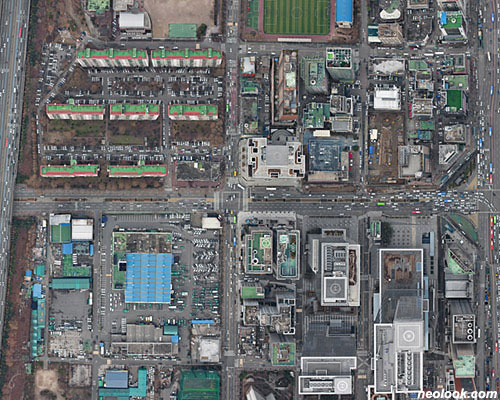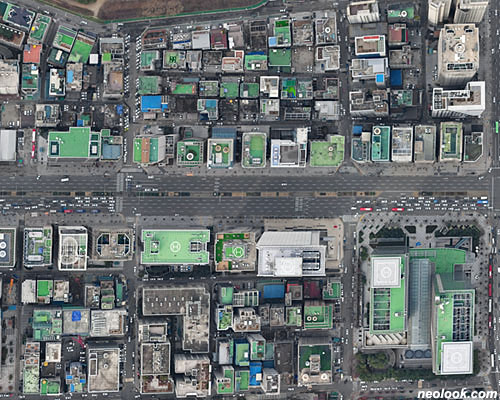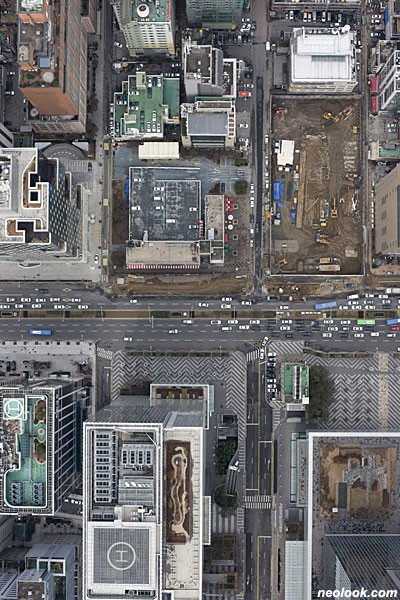- ● homepage
- ● archives
- ● restoration
- ● books
- ● big banners
- ● post board
- ■ neo's search
- ■ about us
- ■ 게재방법 안내
- 개인정보처리방침

- [email protected]
- Tel. 02_335_7922
- Fax. 02_335_7929
- 10:00am~04:30pm
- 월요일~금요일
- 3/3(월) 대체공휴일

테헤란 Teheran
이득영展 / LEEDUEGYOUNG / 李得榮 / photography 2009_0810 ▶ 2009_0904
● 위 이미지를 클릭하면 네오룩 아카이브 Vol.20080218c | 이득영展으로 갑니다.
초대일시_2009_0811_화요일_06:00pm
후원_서울특별시_서울문화재단_문화예술위원회_한국디자인문화재단_엡손_캐논
관람시간 / 11:00am~08:00pm
한국디자인문화재단 갤러리 D+ KOREA DESIGN FOUNDATION GALLERY D+ 서울 종로구 신문로 2가 1-160번지 Tel. +82.2.735.9611~18 designfo.org
서울이라는 도시는 다른 나라와는 확연히 다른 특징을 가진다. 그 특징이 건축물의 시각적 복잡함에만 머무르는 것이 아니라 그 구조에 따른 사회적, 문화적, 현상학적 특성을나타내고 있다. 60-70년대의 서울시에는 "도시는 선이다," "시공은 예술이다"라는 건설이 숭배되는 표어가 유행이었고 지금의 서울이라는 도시도 여기저기서 경제적 효용성이라는 논리로 재개발과 재건축이 진행되고 있으며 위성도시들이 신도시라는 이름으로 만들어 지고 있지만, 지금의 강남이라는 곳은 다른 곳과는 구별되는 특별한 장소성을 가지고 있다. 그중에서도 테헤란로는 대한민국을 대표하는 경제 성장의 아이콘을 특징으로 하고 있다. ● 석유 파동을 겪으며 원활한 석유공급을 위해서 이란과 수교하면서 이란에는 서울 street을 만들고 서울에는 테헤란로를 만들었지만, 처음에는 허허벌판의 거리에 지나지 않았었다. 지하철 2호선이 지나면서 삼성, 선릉, 역삼, 강남역이 만들어진 이후에 그 주변에 초고층 빌딩이 들어섰고 불과 몇 년 만에 현재의 모습이 완성되었다. 40m 테헤란로의 길 옆 에는 초고층 빌딩이 들어서 있고 그 바로 이면에는 3-4층의 근린생활시설이 보조하는 역할을 하고 있으며 그 안쪽에는 4-8m의 이면도로가 다가구 다세대 주택들의 경계를 이루고 있다. 이 작업은 대한민국 수도 서울에 있는 테헤란로와 이란의 수도 테헤란에 있는 서울로에 대한 2개의 주름진 공간에 대한 이야기이다. ■ 이득영

- 이득영_테헤란_피그먼트 프린트_95×850cm_2009_부분
생각하는 기관들 ● 투수는 투수판을 밟은 뒤 포수의 사인을 지켜본다. 고개를 한 번 돌리더니 이내 끄덕거린다. 깊은 심호흡을 내쉰다. 그리고 양팔을 머리 위로 올렸다 내리면서, 왼쪽 다리를 허리 높이까지 들어올린다. 양 팔과 왼쪽 다리가 만난다. 잠시 정적. 그는 0.3초가량 동작을 멈췄다가 왼쪽 발로 마운드를 내딛으며 상체를 앞으로 밀고 나간다. 글로브에서 투수의 오른손이 빠져나온다. 공의 실밥을 쥔 손가락 그립이 얼핏 보인다. 이제 투수는 오른쪽 귀 높이까지 서서히 공을 들어 올린 뒤 정통파 오버핸드의 자세로 던질 것이다. 어깨는 회전하고, 팔꿈치는 꺾이고, 손목은 낚아채고, 손가락은 뿌린다. 투수의 손을 떠난 공은 느린 직구처럼 보이지만, 포크볼이 분명하다. ● 보통 투수가 던지는 공은 회전한다. 직구든 변화구든 상관없이 공은 제 몸을 끊임없이 빙빙 돌려야만 한다. 그래야만 자신의 주변에 작은 소용돌이를 만들어내고, 공기를 좌우로 물리치며 앞으로 나갈 수 있다.

- 이득영_테헤란_피그먼트 프린트_95×850cm_2009_부분
종종 회전수가 많은 공은 그 끝이 살아 있는 듯 홈플레이트 앞에서 휘어지기도 한다. 그런데 포크볼은 다르다. 회전하지 않는다. 회전을 거부한다. 그것은 아무런 보호의 장막 없이 제 앞의 공기와 계속 부딪친다. 그러니 투수의 손을 떠난 공은 점점 속도가 감소하다가 결국 낙차가 큰 포물선을 그리며 지상을 낙하한다. 멀쩡하게 날라 오던 공이 그렇게, 뚝, 떨어진다. ● 타자는 포크볼이 세상과 대면하는 방식을 좋아한다. 아마도 약 0.4초도 못되는 시간이 지난 후에 공은 홈플레이트 50cm 밑에서 약 15cm 정도 아래로 떨어지기 시작할 것이다. 그리고 무릎 정도의 높이를 통과해 그를 스쳐지나간 후 포수의 미트에 꽂힐 것이다. 포크볼의 낙차가 예상보다 더 크다면, 포수는 재빨리 무릎을 꿇고 블로킹을 해야 할 것이다. ● 판단은 순간적으로 이뤄진다. 타자는 자신의 몸을 구성하는 기관들의 견해를 존중한다. 그 견해들의 총합이 자신을 더 자신답게 만든다고 타자는 믿는다. 이미 그의 눈은 투수의 손가락 그립에 대한 정보를 온 몸의 기관들에 전달했다. 그 이후에도 공의 이동 속도와 궤적을 계속 모니터링하는 중이다. 스윙은 시작되었다. 그의 왼쪽 다리는 리듬을 타듯 가볍게 들려 올려지고, 오른쪽 어깨는 활을 잡아당기듯 배트를 뒤로 잡아끈다.

- 이득영_테헤란_피그먼트 프린트_95×850cm_2009_부분
다른 기관들도 부산하다. 그것들은 눈이 보내준 정보를 바탕으로 포크볼에 대한 대처 방안을 강구하는 중이다. 생각은 머리만 하는 것이 아니다. 머리가 생각하고 기관들이 그 뒤를 따르는 방식으로는 이 상황에 대처할 수 없다. 사색의 시간은 주어지지 않는다. ● 따라서 모든 기관들이 동시다발적으로, 따로 또 같이 생각해야 한다. 몸의 자연스러운 중심이동을 돕는 왼쪽 엄지발가락부터, 타격 시 공의 반작용에 탄력을 불어넣는 오른쪽 손목의 관절까지. 타자는 오랜 시간동안 헤아릴 수 없을 만큼의 스윙연습과 무수한 시행착오를 거듭해 왔다. 그리고 그 결과로, 배트는 그의 기관들 중 하나가 되었고, 몸의 일부가 되었다. 또한 몸의 기관들 역시 근육의 반복적인 길항을 통해 기억하는 방법을 터득했으며, 그렇게 기억된 정보들을 바탕으로 생각하고 서로 대화를 나누기 시작했다. 여기에는 위계도, 중심도 없었다. 스윙이 있고 기관들이 있을 뿐이었다. ● 타자는 기관들의 만장일치를 선호했다. 모든 기관들이 동일한 해결안을 내놓는 순간, 그는 자신의 스윙에 자신감이 넘친다는 걸 알고 있다. 비록 잘못된 판단의 결과였고 팀의 패배를 불러온다고 하더라도 상관없다. 바로 그 순간이 그의 기관들이 바로 그를 그답게 만들기 때문이다. 이번에도 마찬가지다. 판단은 순식간에 이뤄진다. 기관 들 중 하나가 의견을 제시하면, 다른 기관들은 동의를 표하거나 반론을 제기할 것이다. 만일 다른 기관들이 모두 동의한다면, 견해의 만장일치가 이뤄진다. 만장일치에 실패할 경우, 그의 양 어깨와 손목은 무리를 해서라도 스윙을 멈추려고 할 것이다. 어설픈 다수결로 의견이 나뉠 경우, 스윙하는 도중 타자의 폼은 무너질 것이다. 그리고 내야 땅볼이나 헛스윙으로 끝나고 말 것이다. ● 여전히 공은 비행 중이다. 실밥이 보인다. 회전하지 않고 있다. 제일 먼저 의견을 제시한 기관은, 타자의 오른쪽 팔꿈치다. 이미 가슴 밑까지 내려온 팔꿈치는 공이 낙하하는 포물선의 궤도를 계산한 후, 정확히 타격 지점을 제시한다. 그의 기관들은 경험 많은 팔꿈치의 견해를 신뢰한다. 타자는 원래 투수였다. 그것도 포크볼 구사에 정평이 난 투수였다. 그러나 그는 포크볼을 던지면 던질수록 자신의 팔꿈치 인대가 닳아 없어지고 있다는 사실을 알지 못했다. 그는 팔꿈치의 비명 소리를 듣지 못했다. 그는 수술대 위에 올랐다.

- 이득영_테헤란_피그먼트 프린트_95×850cm_2009_부분
그리고 얼마간의 재활. 결국 그는 포크볼을 던지는 투수이길 포기하고 포크볼을 칠 수 있는 타자가 되기로 마음먹었다. 흥미롭게도 그가 기관들의 옹알이를 처음 듣게 된 것은 그런 결심을 한 후였다. 지금, 그는 이 상황에서 팔꿈치가 대처방안을 내놓았다는 사실에 안도한다. 팔꿈치는 포크볼을 가장 잘 알고 있는 기관이기 때문이다. 남은 일은 몰아의 상태에서 팔꿈치가 지휘하는 기관들의 움직임에 모든 것을 맡기는 것이다. ● 이제 곧 투척의 궤적과 스윙의 궤적이 교차할 것이다. 선과 선이 서로 만나는 점, 오른쪽 팔꿈치가 정확히 예측했던 바로 그 점에서 타자의 배트는 공을 맞출 것이다. 기관들이 응축했던 에너지가 그 점을 향해 폭발할 것이며, 야구장의 좌표적 공간이 그 점 속으로 빨려 들어갈 것이다. 하나의 홈플레이트와 세 개의 베이스와 아홉 명의 수비수와 네 명의 심판도 "딱"하는 경쾌한 타격음과 함께 당신의 시야에서 사라질 것이다. 그렇게 모든 것들이 점으로 빨려 들어간 후, 마치 최신의 분사엔진을 단 듯 유유히 창공을 활공하는 비행 물체만이 남을 것이다. 적어도 타구가 땅에 떨어질 때까지, 야구장을 지배하는 것은 타구와 그것에 작용한 힘들의 크기와 방향뿐이다. 야구장은 일시적으로나마 그렇게 벡터적 공간이 될 것이다. ● 그리고 얼마 후 야구장은 본래의 모습으로 되돌아갈 것이며, 관중석의 누군가는 우측 펜스 뒤쪽에 떨어졌던 공을 집어들 것이다. 그는 그 공이 짧았던 처녀비행의 기억뿐만 아니라, 타자의 기관들이 행했던 판단과 행위들의 흔적까지 제 몸에 새겨 넣고 있다는 사실을 알지 못할 것이다. ■ 박해천

- 이득영_테헤란_피그먼트 프린트_95×850cm_2009_부분
Seoul as a city has characteristics distinctive from those of other cities in other countries. Such characteristics do not simply lie in the visual complexity that its buildings create. They also show social, cultural and phenomenological quality of the social structure found in Seoul. ● Throughout the 1960s and the 1970s, slogans worshipping building construction, such as "a city is its lines", "construction is an art" were in fashion. Today, various areas of Seoul are being redeveloped and reconstructed in the name of economic utility, and satellite cities called "new towns" are being built. Even while such changes are being made, Gangnam, the South Bank, today has extremely distinctive placeness that cannot be found anywhere else. ● Among other parts of Gangnam area, Tehran Avenue especially has a characteristic of being an icon of economic development, representing that of the "Republic of Korea". Tehran Avenue was built simultaneously with and as a parallel to Seoul Street in Tehran, when the South Korean government signed a treaty of amity with the Iranian government in order to secure and optimise oil supply. By the time the construction was complete, however, it was nothing but a vast expanse of empty space. It is only after the construction of Samseong (삼성, 三成), Seolleung (선릉, 宣陵), Yeoksam (역삼, 驛三) and Gangnam (강남, 江南) stations on subway line number 2 that tall buildings started to appear along the avenue. Within only a few years, Tehran Avenue became what it is today, taking the shape that it largely still holds. Today, skyscrapers line both sides of the avenue, behind which lie various neighbourhood living facilities of three to four stories that play a supporting role. Further behind the avenue, four-to-eight-meter-wide local streets are found surrounding townhouses and multi-family homes. ● These photographic works tell a story about two folded spaces, which are Tehran Avenue in the capital of "Republic of Korea", Seoul, and Seoul Street in Iran's capital city, Tehran. ■ LEEDUEGYOUNG

- 이득영_테헤란_피그먼트 프린트_95×850cm_2009_부분
Thinking Organs ● The pitcher steps onto the mound and controls his breath, watching intently the signals from the catcher. He nods shortly after having shaken off once. He takes a deep breath. He lifts up his left leg to the waist, while raising his arms over his head and bringing them down. Both of his arms and his left leg meet. He holds still for a moment. Following a 0.3 second's pause, he thrusts his upper body forward, landing the left foot on the mound. His right hand escapes the glove. A glimpse of the grip on the seams. Now the pitcher is going to slowly lift up the ball to the level of his right ear, and throw in the orthodox overhand position. The shoulder spins, the elbow bends, the wrist snatches, and the fingers fling. The ball that just left the pitcher's hand may look like a slow straight throw, but it sure is a forkball. ● Usually, a baseball spins when thrown by a pitcher, regardless of it being a straight throw or a breaking ball. It spins incessantly, and this way it makes small swirls around itself, and advances through the surrounding atmosphere. Sometime a ball with a high spin rate bends near home plate as if its tip were alive. But a forkball is different. It does not spin. It refuses to spin. It struggles through the air without any protective shell around. So, after having gradually slowed down since it left the pitcher's hand, it drops sharply in a parabolic motion. The ball just drops, out of a sudden. ● The batter likes the way a forkball faces the world. Probably within less than 0.4 seconds, the ball will start to drop by approximately 15cm leaving 50cm to the home plate. It will pass him by at his knee level and dive into the catcher's mitt. If the ball falls even more sharply than expected, the catcher will have to swiftly change position to block the ball on his knees. ● Judgement is made instantly. The batter respects the opinions of his organs. He believes that the sum of such opinions makes him more himself. His eyes have already transferred the information on the pitcher's grip to all the organs, while continuing to monitor the speed and the course of the ball. He launches his swing. His left leg is lightly lifted to the rhythm, and his right shoulder brings the bat back as if drawing a bow. The other organs become busy as well. They are considering the measures against the forkball on its way, based on the information received through the eyes. Thinking is not reserved for the brain. One cannot face such a situation by simply using one's brain and submitting the rest of the body to its decision. There remains no time for contemplation. ● Therefore, one has to think with all and each of the organs simultaneously, from the left big toe that supports smooth weight shift, to the right wrist joint that gives resilience to the ball when hitting. The batter has practised countless swings. He has been through numerous trials and errors. As a result, the bat has become one of his own organs, a part of his body. Through repeated antagonism of the muscles, each part of his body has learned to remember. The organs started to communicate with one another based on saved data. There is neither hierarchy nor centre among the organs. There only are swings, and the organs. ● The batter prefers the unanimity among the organs. The moment when the solution drawn from each organ is identical, he knows that his swing will be an especially confident one. It doesn't matter even if it is a wrong decision that may result in the team's defeat, because at such a moment, his organs make him himself. Same story this time. The decision is made instantly. One of the organs makes a suggestion. The others either agree or disagree. If all the others agree, there is unanimity. If not, his shoulders as well as wrists may try to stop the swing by force. If no consensus is reached, the Batter's form will collapse in the middle of the swing. He will end up with an infield out or an air swing. ● The ball is still flying. Still in the air. The batter can see its seams. The ball is not at all spinning. The first organ to make a suggestion is his right elbow. Already dropped down below the chest, it suggests a precise hitting point after having calculated the expected course of the ball. The other organs respect elbow's opinion and express their consent. The batter once was a pitcher. Not just any pitcher, but one well known for his forkballs. However, he did not realise that his elbow ligaments were being worn out as he threw forkballs. He did not hear his elbow scream. After a while, he found himself on an operating table. He was put on a rehab program for some time. Finally he gave up being a forkball pitcher and chose to be a forkball hitter. Interestingly, it was only after such a decision was made that he started to listen to the babbles of his organs. Right now, he feels assured that it is his elbow that is speaking out first, because the elbow knows the best about forkballs. At this moment, there is only one thing left to do: lose himself and let the elbow lead. ● Soon the course of the pitch and that of the swing will cross. Where a line and another meets, at the point accurately estimated by the batter's right elbow, the bat will hit the ball. The energy, condensed in each organ, will explode towards that point, and the coordinate space of the baseball ground will be sucked into that point. With a cheerful sound of the hit, "crack", a home plate, three bases, nine defenders as well as four referees will disappear from the sight. After everything has vanished into one single dot, only thing left will be a flying object that glides freely in the sky as if powered by a state-of-the-art jet engine. At least until the ball lands on the ground, only the batted ball, along with the direction and the size of the force acting on it rule the field. The field will become a vector space, although temporarily. ● Shortly after, the baseball ground will recover its integrity. Someone in the stands may pick up the ball that fell behind the fence on the right. He/She would not know, though, that the ball is engraved not only with the memory of its very first flight that was short, but also with traces of judgements and actions taken by the batter's organs. ■ Park Haecheon
Vol.20090810b | 이득영展 / LEEDUEGYOUNG / 李得榮 / photography

